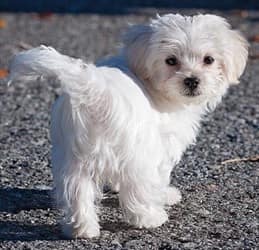The Top 7 Maltese Care Tips
Overview
There is a lot that needs to go into taking proper care of any dog, and even more so when it comes to toy sized breeds. The Maltese adds even another layer to this due to his single coat of white hair.
Here, we will go over the top 7 care tips that every owner should be following to ensure optimum health, comfort, safety, and happiness.
Please note: PetMaltese is reader-supported. Some of the product suggestions on this page are affiliate links. As an Amazon Associate we earn from qualifying purchases. This is at no extra cost to you and helps us continue creating useful content.
Maltese Care Tip #1
These can be very harsh on both the gastrointestinal system and on the skin and coat.
You will also want to steer clear of by-products, generic meat sources, and foods sourced outside of North America.
What to do:
Carefully weigh your options to feed your Maltese the best food possible
for both main meals and all of his treats. Do not assume that any brand is a great one based only on name recognition. Do not settle for anything less than a 4-star food, and a 5-star formula is ideal.
Both kibble and snacks should be wholesome, all-natural, with no additives, easily digested ingredients, and made in North America (includes both the US and Canada.
For main meals, Wellness CORE Natural Dry Grain-Free for Small Breeds
 is a great choice. This is hard to beat in all aspects of what a top food should be. It is a premium food that is all-natural and made in the USA.
is a great choice. This is hard to beat in all aspects of what a top food should be. It is a premium food that is all-natural and made in the USA.
It has no wheat, corn, soy, meat by-products, or artificial colors, flavors or chemical preservatives. There are no fillers. It has probiotics for immune health, and omegas for healthy skin and coat. It's easy on the digestive system, and it is sized for little dogs.
Ingredients include turkey (#1 ingredient), chicken, potato, peas, flaxseed, spinach, broccoli, carrots, apple, and blueberries.
For snacks, Fruitables Pumpkin & Blueberry Crunchy Dog Treats
 is a fantastic treat. This is just one of their many flavors; others are bacon & apple, sweet potato & pecan, strawberry Greek yogurt, and pumpkin along with other fruits like blueberry, cranberry, and banana.
is a fantastic treat. This is just one of their many flavors; others are bacon & apple, sweet potato & pecan, strawberry Greek yogurt, and pumpkin along with other fruits like blueberry, cranberry, and banana.
These are made in the USA, and have zero artificial additives.They are preserved the healthy way by using vitamins. And, these are a tiny size, which makes them perfect for Maltese puppies and dogs.
Maltese Care Tip #2
Do not offer un-filtered tap water.
It is quite shocking what is found in tap water across the country.
There are both regulated and unregulated chemicals, toxins, and harmful agents in tap water, and it is really a shame that not all pet owners realize this.
Since dogs drink water and nothing else, days, weeks and years of ingesting these sorts of elements can be detrimental to their health.
The Environmental Protection Agency, which updates their findings yearly, generally lists over 100 unregulated contaminants that have made their way into water supplies.
But, it is what is known
to be in the water that is troubling to say the least.
Of concern are the large number of chemicals that are added to water to kill bacteria and other microorganisms. These are often deemed 'safe' based on one 8 oz. serving for a 170 pound adult male.
One major issue is chlorine. While long term effects have not been studied on dogs, it has been found that cancer risk increases a whopping 93% for people whose water contains chlorine.
Another issue is fluoride. It is an insecticide that was used as cockroach control pre-1900, to control poultry lice starting in 1915, and was used extensively during WWII to control insects. It discolors human babies' teeth and is toxic to canines. Moderate amounts can cause stomach distress, and large amounts can lead to kidney damage.
Other concerns
are lead, mercury, PCBs, arsenic, perchlorate, dioxins, DDT and Chromium-6 (known cancer-causing agent recently found in the tap water of over 200 million Americans).
And, though it is nothing compared to these very serious possible health risks, if you struggle to
keep your Maltese looking pure white, unfiltered tap water is one of the culprits.
What to do:
There are some good options to help make the water that your Maltese drinks is safe.
You may wish to install a filtering device to your kitchen sink, obtain a filtering water pitcher like the Aquagear Water Filter Pitcher , which is FDA approved to filter out Chromium-6, fluoride, chlorine, mercury and lead among many other toxins, or offer bottled spring water.
, which is FDA approved to filter out Chromium-6, fluoride, chlorine, mercury and lead among many other toxins, or offer bottled spring water.
Maltese Care Tip #3
Take care of your Maltese's teeth.
This is one care tip that is overlooked by far too many owners, and it often has dire consequences.
Canines are no different than humans in regard to plaque constantly being produced. It clings to teeth, and starts to harden into tartar in as little as 3 days.
If it is not properly and thoroughly removed on a regular basis, it eats away at the enamel. It also travels under the gum line to destroy teeth.
Chewing toys only provides a marginal cleaning, and is not close to what is needed for proper oral hygiene.
-min-335x250-1920w.jpg)
Louie, at 2 and 1/2 years old, photo courtesy of Pat & Joe Albertini
Tooth decay seen with canines is a painful and sometimes deadly issue that can lead to infection, loose teeth, loss of teeth, and even sepsis. And of course, bad breath
is a commonly seen issue when there is a lack of dental care.
Fortunately, there are steps you can take to help prevent this with your Maltese puppy or dog.
What to do:
There are 4 things that will work together to protect the integrity of your Maltese's teeth:
1.
Brush using an effective canine toothpaste. this should be fluoride-free and non-foaming since the paste is meant to be swallowed. It helps if it is a taste that dogs find pleasing, which includes chicken or vanilla.
2.
Use a properly sized toothbrush or pet finger-toothbrush (meant to slip over your index finger). It can be efficient to use a 3-sided brush that can scrub all sides of the teeth at one once. You may find that a fingertip-brush works well for tiny Maltese, as it may make it easier to reach into little mouths to scrub.
For a kit that contains an effective paste, a 3-sided brush, and a finger-brush, the Nylabone Advanced Oral Care Dental Kit
 is ideal. For puppies and adults under 10 pounds, the 'puppy size' option usually works well.
is ideal. For puppies and adults under 10 pounds, the 'puppy size' option usually works well.
3.
Or, use a dental spray. Some dogs do not tolerate having their teeth brushed. This should never be assumed, since it one of the most effective ways to keep teeth clean; but, if a Maltese has indeed shown an intolerance that makes this task almost impossible, it will be time to use an alternative method.
In these cases, certain sprays like Spray Me: Doggy Dental Spray
 can be a good option. These are much less evasive and used regularly can reduce plaque and tartar over time.
can be a good option. These are much less evasive and used regularly can reduce plaque and tartar over time.
4. Offer a quality canine dental chew each day. These are specially designed treats that help remove plaque and should be given on top of which ever method you have chosen to clean your Maltese's teeth at home (brushing or spray). Note that these have a hard consistency and are meant to be given while a dog is supervised.
One of the most popular ones for dogs is Greenie Teenie Dental Chews . These are very effective and have been awarded the Seal of Acceptance from the Veterinary Oral Health Council for removing and preventing plaque and tartar.
. These are very effective and have been awarded the Seal of Acceptance from the Veterinary Oral Health Council for removing and preventing plaque and tartar.
These are made with natural ingredients, also help freshen breath, come in a grain-free option, and importantly, are sized nicely for Maltese puppies and dogs that are between 5 to 15 lbs.
-min-320x240-1920w.jpg)
Albi, at 2 years old, photo courtesy of Margaret Mohamed
Maltese Care Tip #4
Help your Maltese meet daily exercise requirements.
While a small toy breed like the Maltese can certainly romp around quite a bit inside, this is not the same as purposeful, outdoor exercise.
A Maltese should ideally have two 20 to 30 minute walks per day, at a pace that is brisk for the puppy or dog.
Sustained, low-cardio exercise such as this has many benefits. It keeps the heart healthy, regulates metabolism, is good for the immune system, and is great to maintain muscle ratios which are all important for physical health.
It also allows a dog to engage his canine senses, and helps him release pent-up energy, both of which are important for emotional health.
What to do:
Keep to a walking schedule with your Maltese. If you are rushed in the morning, try to wake up a bit earlier. If you are too busy after dinner, try to delegate household tasks to other family members.
Do not allow weather to get in your way, unless there is torrential rain or a severe snow storm. Dress your Maltese in appropriate clothes if needed (lined vest or winter coat), and be sure to dress warmly yourself.
So that your Maltese's paws are protected both in the winter and on hot summer days, use a quality paw wax like Musher's Secret Paw Protection Wax .
.
Make walks fun by trying out new walking routes or using the time to practice heeling.
Maltese Care Tip #5
If driving your Maltese, always use a canine car seat.
Buckling up a puppy or dog is no different than doing so for a child. It's vital to protect your Maltese this way. There are over 16,000 car accidents per day just in the U.S. and even if you are a fantastic driver, you have no control over those around you or the road/weather conditions.
It is alarming how unrestrained pets are thrown when an accident occurs. The general crash force is based on an object's weight, times the speed.
Therefore, in a crash at 25 MPH, an unrestrained 4 lb. Maltese would be thrown as if he were a 100-pound object. Going 55 MPH with a 5 lb. Maltese? He'd be thrown as if he were a 275-pound object.
In addition, the right car seat can dramatically cut down on motion sickness, since an inability to properly see out of a window is one of the top causes.
What to do:
Obtain a canine booster car seat that is sized for toy breed dogs. Booster seats like the Kurgo Skybox Dog Booster Seat
 are best for Maltese since these keep the puppy or dog up high where they can have line-of-sight.
are best for Maltese since these keep the puppy or dog up high where they can have line-of-sight.
You will notice that inside the seat is a short buckle. This is NOT to be connected to a collar, as doing so can cause terrible neck injury or even death in the event of an accident. These are meant to be connected to a dog's harness, which keeps all pressure off of the neck.
Maltese Care Tip #6
Proper coat care.
There are several elements to keep in mind in regard to grooming:
Brushing
- This serves many purposes including clearing the coat of debris and dead hairs, stimulating hair follicles, and distributing body oil down through the coat. For hairs that are long enough to tangle, brushing will help prevent this.
The timing for this depends on the length of your Maltese's coat. Short puppy cuts should be brushed about every 3 days. Long coats often need a daily brushing.
For pups and adults that have short coats, a bristle brush often works best. A recommended one is the Chris Christensen Soft Tufted Boar Brush
 which is a good size for this breed with quality bristles that offer the right degree of tension.
which is a good size for this breed with quality bristles that offer the right degree of tension.
For those with moderate to long coats, a pin brush is your best choice since this works well to separate hairs. You'll want the tips of the pins to be cushioned or polished so that they do not scratch your dog's skin (even so, be careful as you go). For this, the Chris Christensen Little Wonder Pin Brush
 is a top choice.
is a top choice.
Baths
- Baths should be given
once every 3 weeks. More often than this can cause excessive dry skin
and coat, even with great products, because when natural body oils are removed too frequently, the body cannot keep up.
And if you space baths too far apart, there will be an accumulation of body oils. This can block skin pores and natural air circulation. It can also cause a dog to have an odd odor.

Kirby, at 5 years old, photo courtesy of the OMelia-Neidermeyer family
Products
- Using the right bathing products
is vital for both skin and coat health. Inferior shampoos and conditioners can be quite harsh, cause drying, and can lead to all sorts of issues such as discoloration, split ends, and brittle texture.
You'll want to use a good leave-in spritz, which will protect the coat from the sun, dry air, and contact friction.
Eye care
- While dogs are notorious for developing tear stains, and of all dogs with this problem, the Maltese is often at the top of the list.
There are some care elements that can keep this at bay:
- Never use plastic bowls. Even those that are BPA free can cause contact allergies that can discolor hair and even cause noses to fade. Use stainless steel instead.
- Offer only filtered water since metals in tap water can cause tear staining.
- Wipe your Maltese's face 2 to 3 times per day, preferably after each meal, with a quality canine wipe.
- If your Maltese has heavy tear stains, use an effective product like Eye Envy Tear Stain Remover
.
Bella, at 9 years old, photo courtesy of Silvia McNeil
Maltese Care Tip #7
Bring your Maltese for veterinary wellness checks.
Just about everyone brings their dog to the vet in the event of an injury or illness, but what about preventative visits?
All adult dogs should have a wellness exam once per year, and seniors 8 years and older need twice-per-year geriatric checkups.
This is the best way to know that you are on track, and to catch any issues early.
These generally consist of a full physical exam, checking a dog's vitals, stool testing, urinalysis, a through visual exam of skin, coat, paws, ears, eyes, nose, and mouth, and often a check of the joints including knees and hips.
The need for vaccinations
will be discussed and you may want to request a titer test before agreeing to a yearly booster.
During the appointment, you can also take this time to ask the vet any questions that you may have, and the vet will often discuss your dog's diet and exercise program.
-min-250x250-1920w.jpg)
Specific advice and tips concerning young pups

Issues that can occur; treatment and prevention
Housebreaking a Maltese Puppy
- Fast success,
working as a team
You May Also Like:
How to Help a Bored Maltese Stay Busy - A wonderful article with creative, fun ways to help keep a Maltese occupied. Includes 6 activities to go together and 6 activities for independent play.
Helping a Maltese with Separation Anxiety
- Effective ways to help a Maltese be okay when home alone.
Maltese Dogs and Emotional Stress
- Signs a Maltese is stressed, top triggers, health consequences, and 20 things you can do right now to help your Maltese feel better.
The Best Harnesses for Maltese
- Throw that collar away and use a harness instead. This will help prevent collapsed trachea and other collar-related issues.
Safe Parasite Protection for a Maltese
- Help with choosing heartworm, flea, and tick protection with the least chance of adverse side effects.
Maltese Summer Care Tips
- 7 important care elements to keep your Maltese happy, safe, and comfortable during the summer.
Maltese Chewing and Teething Issues
- Exactly how to resolve any sort of chewing problems.

-min-450x169-1920w.jpg)

-min-320x165-1920w.jpg)

-min-321x335-1920w.jpg)
